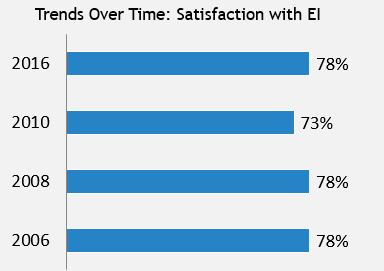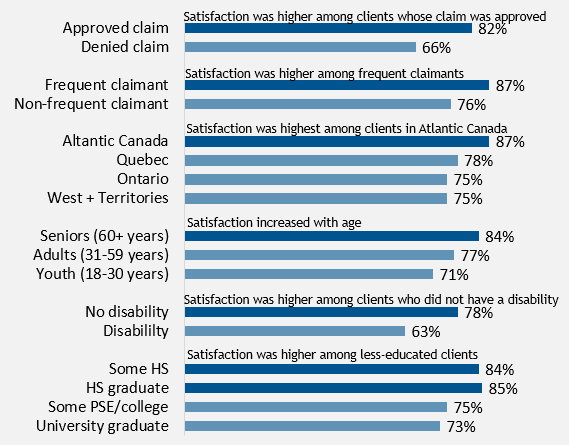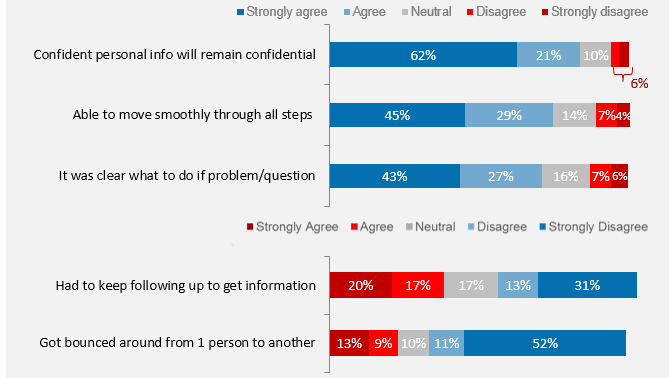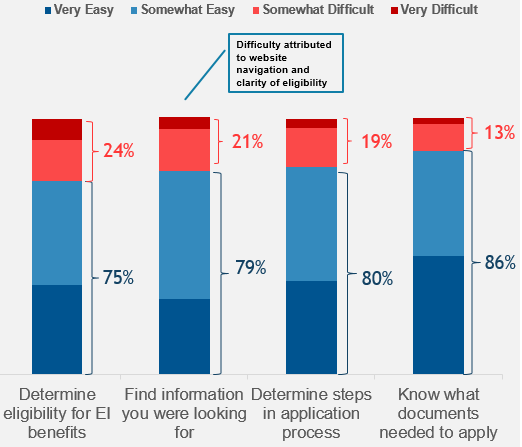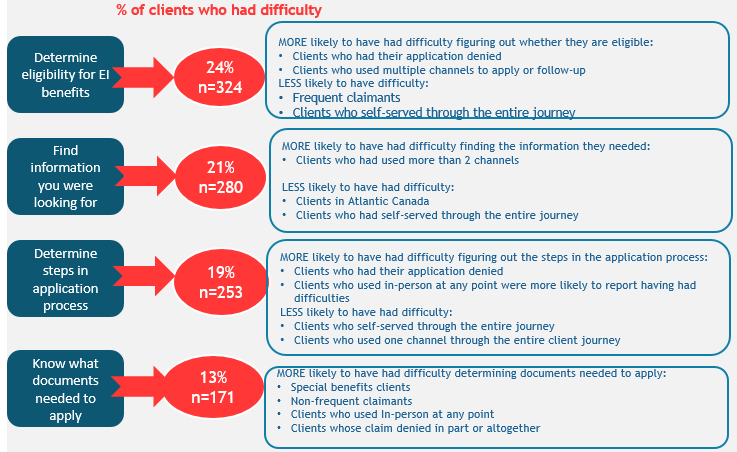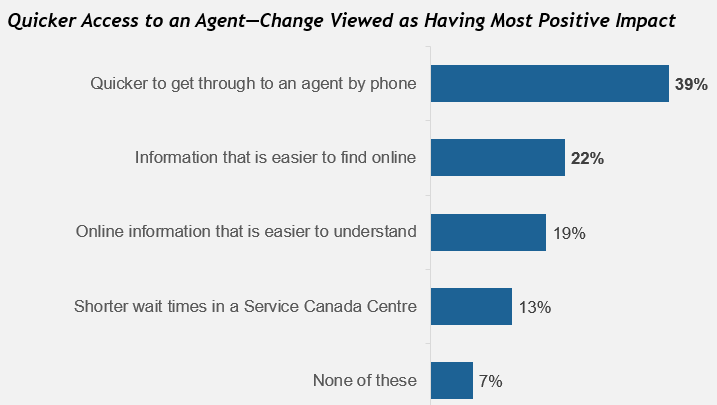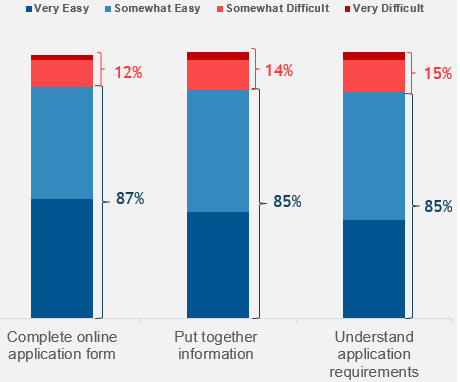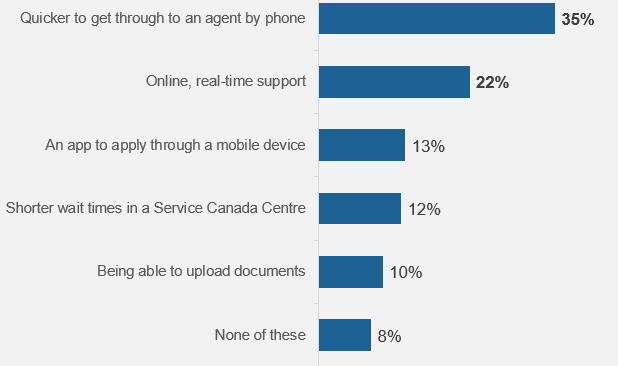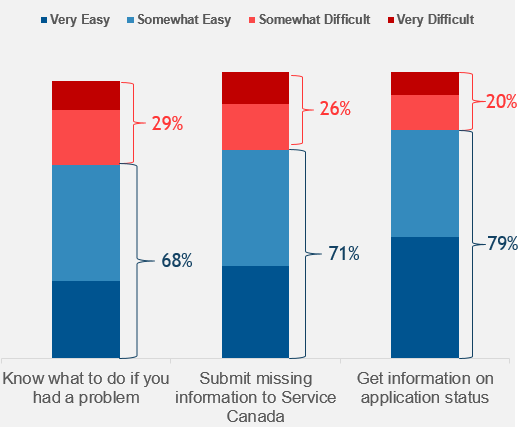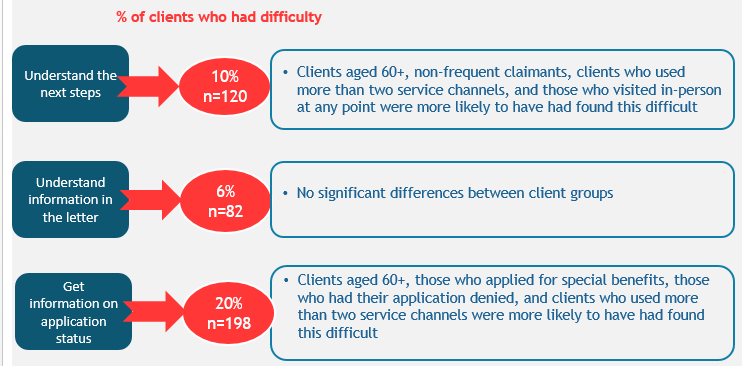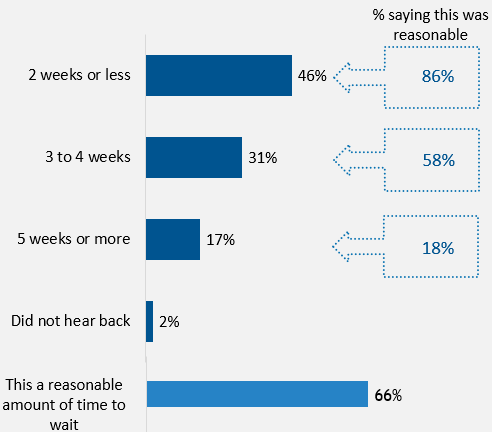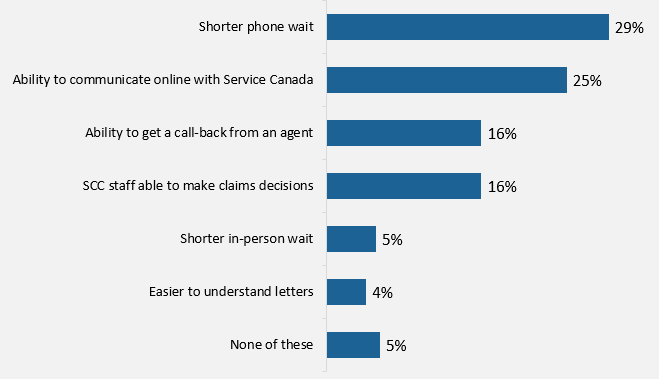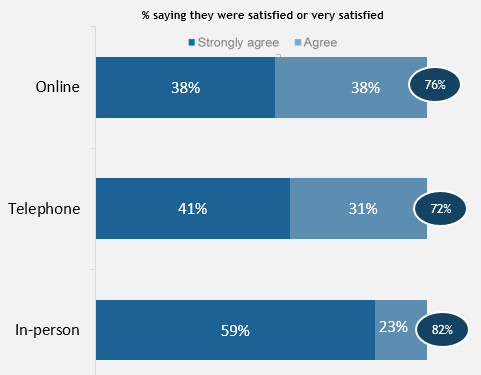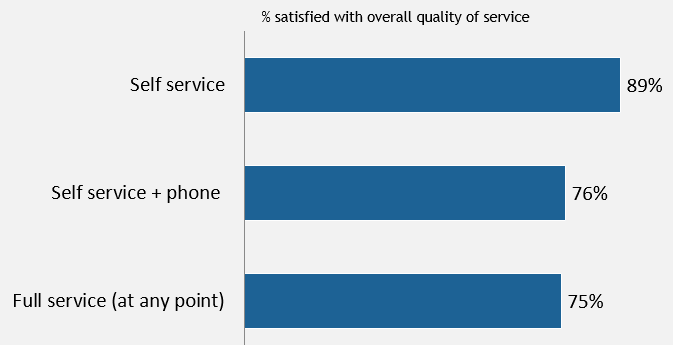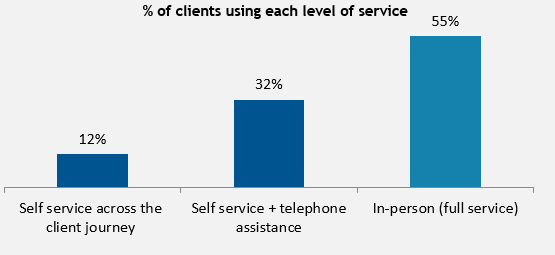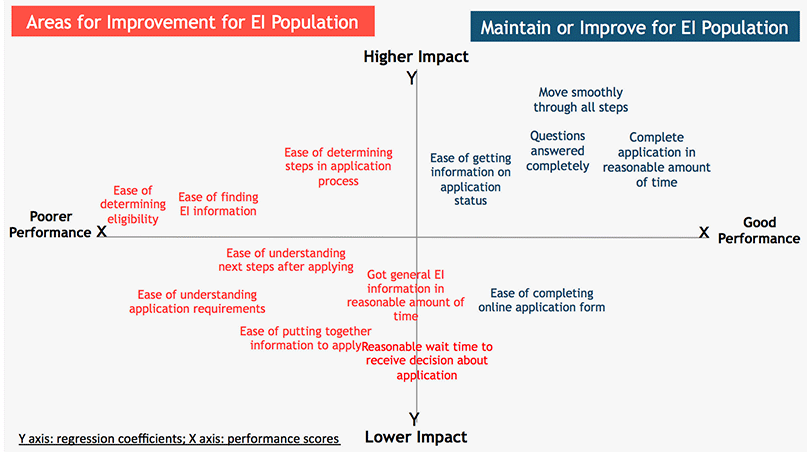« Ce rapport est aussi disponible en français. »
Appendix 1 Survey Questionnaire
Service Quality Review: EI Claimant Survey
FINAL: 2016-09-08
Introduction
Hello, may I speak to [Insert: your name](INSERT CLAIMANT’S NAME FROM LIST)
- IF PERSON IS AVAILABLE, CONTINUE.
- IF NOT AVAILABLE, ARRANGE CALL-BACK OR GET NEW NUMBER WHERE PERSON CAN BE REACHED.
IF NECESSARY, EXPLAIN PURPOSE OF PHONE CALL. SAY “I’M CALLING ON BEHALF OF THE GOVERNMENT OF CANADA TO ASK SOME QUESTIONS ABOUT THE QUALITY OF SERVICE PROVIDED BY THE GOVERNMENT”.
IF ASKED HOW WE GOT THE PERSON’S NAME, INFORM THEM IT WAS DRAWN FROM A RANDOM SAMPLE OF CANADIANS WHO MAY HAVE RECEIVED SERVICE FROM THE GOVERNMENT OF CANADA.
Would you prefer to continue in English or French? / Préférez-vous continuer en anglais ou en français? [SEE PROGRAM NOTE ON NEXT PAGE]
Hello, my name is [Insert: your name]. I’m calling on behalf of Phoenix, a Canadian public opinion research company. We’re conducting a survey for the Government of Canada to ask questions about the quality of service it provides to Canadians. This survey averages 15 minutes in length, and is registered with the national survey registration system.
Your participation in the research is completely voluntary and your decision on whether or not to participate will not affect any dealings you may have with the Government of Canada. By answering these questions, you will help the government improve the service it provides to Canadians. The information you provide will be used for research purposes only and will be administered in accordance with applicable privacy laws. Would you be willing to take part in this survey?
- Yes [CONTINUE]
- No [TRY TO SCHEDULE CALLBACK]
S1. During the past 7-8 months, have you been in contact with the Government of Canada to get information or service related to Employment Insurance?
- Yes [GO TO Q1]
- No [CONTINUE]
- Refused [THANK AND DISCONTINUE]
S2. Did someone else contact the Government of Canada during the last 7-8 months on your behalf about Employment Insurance?
- Yes [INVITE PROXY RESPONDENT]
- No [THANK AND DISCONTINUE]
- Refused [THANK AND DISCONTINUE]
Interviewer/Programming Notes
SURVERY REGISTRATION SYSTEM: IF RESPONDENT ASKS ABOUT NATIONAL SURVEY REGISTRATION SYSTEM, SAY:
The registration system has been created by the survey research industry to allow the public to verify that a survey is legitimate, get information about the survey industry or register a complaint. The registration system’s toll-free phone number is 1-800-554-9996.
PROXY RESPONDENTS: IF RESPONDENT IS NOT COMFORTABLE PARTICIPATING IN THE SURVEY FOR WHATEVER REASON (OR HAS TROUBLE UNDERSTANDING WHAT THE INTERVIEWER IS SAYING), INFORM THE RESPONDENT THAT HE/SHE CAN IDENTIFY SOMEONE ELSE TO ANSWER QUESTIONS ON HIS/HER BEHALF IF THAT PERSON HAS DEALT WITH THE GOVERNMENT OF CANADA ON HIS/HER BEHALF. IF SO, TAKE NAME/PHONE NUMBER OF PROXY CONTACT AND ASK RESPONDENT TO CONTACT THAT PERSON RIGHT AWAY TO INFORM THEM THAT THEY WILL BE CALLED (AND HAVE BEEN AUTHORIZED TO ANSWER ON THE RESPONDENT’S BEHALF). THIS IS MOST RELEVANT FOR DISABLED CANADIANS AND NEW CANADIANS, BUT NOT ONLY.
LANGUAGE OF SURVEY: IF THE RESPONDENT PREFERS TO RESPOND IN FRENCH [IF INTERVIEW IS STARTED IN ENGLISH], THEN THE INTERVIEWER MUST BE ABLE TO EITHER PROCEED WITH THE INTERVIEW IN FRENCH OR READ THE FOLLOWING STATEMENT: "JE VOUS REMERCIE. QUELQU'UN VOUS RAPPELLERA BIENTÔT POUR MENER LE SONDAGE EN FRANÇAIS." THE REVERSE IS TRUE FOR INTERVIEWS COMMENCING IN FRENCH.
HOW WE OBTAINED RESPONDENT’S NAME: IF RESPONDENT ASKS HOW WE GOT HIS/HER NAME, INFORM RESPONDENT OF THE FOLLOWING:
- HIS/HER NAME WAS PROVIDED BY THE GOVERNMENT OF CANADA AS SOMEONE WHO MAY HAVE RECEIVED SERVICE FROM THE GOVERNMENT. IT WAS PART OF A LIST OF CLIENTS WHO HAVE HAD A SERVICE INTERACTION REGARDING EMPLOYMENT INSURANCE.
AUTHORITY TO COLLECT INFORMATION: IF RESPONDENT ASKS UNDER WHAT AUTHORITY THIS INFORMATION IS BEING COLLECTED, INFORM HIM/HER IT IS BEING COLLECTED UNDER THE AUTHORITY OF THE DEPARTMENT OF EMPLOYMENT AND SOCIAL DEVELOPMENT ACT, SECTION 6(a).
EMPLOYMENT INSURANCE/EI PROGRAM: THE TERM ‘EI’ IS OFTEN USED TO DENOTE THE EMPLOYMENT INSURANCE PROGRAM. ENSURE THAT RESPONDENTS UNDERSTAND THIS – THAT THE ACRONYM ‘EI’ REFERS TO EMPLOYMENT INSURANCE.
ASSESSMENTS OF SERVICE CHANNELS: ALL RESPONDENTS WHO HAVE CALLED AN EMPLOYMENT INSURANCE SPECIALIZED CALL CENTRE (I.E. USED TELEPHONE SERVICE) WILL BE ASKED THE QUESTIONS IN THE PHONE SERVICE MODULE. ASSESSING THE OTHER TWO SERVICE CHANNALS [IN-PERSON OFFICE AND ONLINE] WOULD BE DONE RANDOMLY IF SOMEONE HAS USED BOTH THOSE CHANNELS. THE FILTER QUESTIONS TO DETERMINE CHANNEL USAGE ARE Qs 1, 11 & 20.
SCALE INSTRUCTIONS: RESPONSE CATEGORIES/INSTRUCTIONS FOR SOME OF THE SCALE QUESTIONS ARE REPETITIVE. ADJUST THE FREQUENCY OF REPEATING THE INSTRUCTIONS TO ENSURE CLARITY BUT AVOID TEDIUM.
HEADINGS: HEADINGS ARE USED IN THE QUESTIONNAIRE TO STRUCTURE THE CONTENT. THEY ARE NOT TO BE PROGRAMMED OR READ TO RESPONDENTS.
Pre-application—Information Gathering about EI Benefits
I’d like to ask you some questions about your experience getting information about Employment Insurance prior to submitting an application for benefits.
[INTERVIEWER NOTE: Ensure that the respondent is clear that these next questions deal with the steps he/she took before applying for EI.]
1. How did you find out how to apply for Employment Insurance? [READ LIST; RECORD YES/NO FOR EACH ITEM. MULTIPLE RESPONSES ACCEPTED] [USE TOP 4 ITEMS, EXCEPT 1-800 O’CANADA, AS FILTER FOR SERVICE CHANNEL MODULES] [CODING DEFAULT IS EI CALL CENTRE IF RESPONDENT IS UNSURE WHO THEY CALLED]
Visit the Government of Canada website
Call an Employment Insurance Specialized Call Centre
Call 1-800 O’Canada
Visit a Service Canada office
[INTERVIEWER NOTE: ONLY THE RESPONDENT’S EXPERIENCE RELATED TO EI IS RELEVANT NOT THEIR EXPERIENCE WITH OTHER GOVERNMENT PROGRAMS SUCH AS OLD AGE PENSION, CANADA PENSION PLAN, ETC.]
- VOLUNTEERED [DO NOT READ]:
- Do a general online or Google search
- Talk with family or friends
- Previous experience => PROBE TO DETERMINE WHETHER ANY OF THE 4 “READ LIST” CHANNELS WERE
- USED.
- Other (Specify):[ ]
[ASK IF MORE THAN 1 OF THE TOP 4 ITEMS SELECTED AT Q1]
2. Thinking about the government information sources you used, which did you use first? [PROMPT RESPONDENT WITH ITEMS FROM Q1 AS NEEDED]
[POPULATE WITH ITEMS FROM Q1]
[ASK NEXT TWO QUESTIONS IF WEBSITE SELECTED AT Q2]
3. When using the website, did you need any help or assistance?
4. Was the assistance helpful in getting you what you needed?
5. Did you get the information you needed in a reasonable amount of time?
[ASK IF OPTIONS 1-4 SELECTED AT Q1; EVERYONE ELSE GO TO NEXT SECTION]
6. Overall, please tell me how easy or difficult each of the following were when you were getting information about Employment Insurance. Would you say it was very difficult, somewhat difficult, somewhat easy, or very easy to…? [DO NOT ROTATE LIST]
- Find the information you were looking for.
- Determine if you were eligible for EI benefits.
- Determine the steps in the application process.
- Know what documents you needed to apply for EI benefits.
[ASK IF VERY DIFFICULT/DIFFICULT FOR Q6A]
7. You said it was hard to find the information you were looking for. Why was this difficult? [DO NOT READ LIST; ACCEPT 2 RESPONSES]
- Waited on hold too long to speak to telephone agent
- Couldn’t reach the call centre/all lines were busy
- Eligibility information was not clear
- Received conflicting information
- Staff were rude/not sympathetic
- Website was difficult to navigate
- Office was difficult to locate
- Long line at the office
- Other [SPECIFY]: [ ]
8. Thinking about your experience looking for information about Employment Insurance before you applied for benefits… which of the following changes, if any, would have had the biggest positive impact on this part of the process for you? [READ LIST; ACCEPT ONE RESPONSE; ROTATE OPTIONS]
- Information that is easier to find online
- Online information that is easier to understand
- Quicker to get through to an agent on the phone
- Shorter wait times in a Service Canada Centre
- [VOLUNTEERED: None of these]
Application Process—Applying for EI Benefits
Thinking back to when you actually applied for Employment Insurance benefits,
9. Where did you complete your online application? [READ LIST]
- At home
- In a Service Canada Centre, or
- Somewhere else?
- (VOLUNTEERED: Did not apply online)
10. Did you require any help or assistance to complete your online application?
[ASK NEXT TWO QUESTIONS IF ‘YES’ AT Q10]
11. How did you get that assistance? Anywhere else? [DO NOT READ LIST; ACCEPT MULTIPLE RESPONSES] [USE TOP 4 ITEMS, EXCEPT 1-800 O’CANADA, AS FILTER FOR SERVICE CHANNEL MODULES]
- Government of Canada website
- Calling an Employment Insurance Specialized Call Centre
- Calling 1-800 O’Canada
- Visiting a Service Canada office
- Doing a general online or Google search
- Talking with family or friends
- Other [SPECIFY]: [ ]
12. Was the assistance helpful in getting you what you needed?
13. Were you able to complete the application in a reasonable amount of time?
14. Please tell me how easy or difficult each of the following were when you were applying for Employment Insurance. Would you say it was very difficult, somewhat difficult, somewhat easy, or very easy to…? [DO NOT ROTATE LIST]
- Understand the requirements of the application.
- Put together the information you needed to apply for EI.
- Complete the online application form.
[ASK IF VERY DIFFICULT/DIFFICULT FOR Q14C]
15. You said it was hard to complete the online application form. Why was this difficult? [DO NOT READ LIST; ACCEPT 2 RESPONSES]
- Terminology/words used in application was not clear
- Website was hard to find
- Application was hard to find
- Didn’t have the right information to complete the application
- Other [SPECIFY]: [ ]
16. How long did it take for you to be informed about whether you would receive benefits? [DO NOT READ LIST]
- Two weeks or less
- Three to four weeks
- Five weeks or more
- Did not hear back [SKIP NEXT QUESTION]
17. Was this a reasonable amount of time to wait? [INTERVIEWER NOTE: THE QUESTION IS ABOUT THE DECISION REGARDING THEIR EI APPLICATION. WE DO NOT WANT RESPONDENTS TO ANSWER BASED ON THE LENGTH OF TIME IT TOOK TO RECEIVE THEIR FIRST PAYMENT. CLARIFY IF THIS IS NOT CLEAR BASED ON THE RESPONDENT’S RESPONSE.]
18. Which of the following changes, if any, would have had the biggest positive impact on your experience applying for EI benefits? [READ LIST; ACCEPT ONE RESPONSE; ROTATE OPTIONS]
- Quicker to get through to an agent on the phone
- Online, real-time support
- Shorter wait times in a Service Canada Centre
- Being able to upload documents, if required
- Have an app to apply through a mobile device
- [VOLUNTEERED: None of these]
Post-application—Follow-Up
19. After you submitted your EI application, did you…? [READ LIST; RECORD YES/NO FOR EACH ITEM. ACCEPT MULTIPLE RESPONSES]
- Receive a letter* with information about your application
- Need to provide missing information regarding your application
- Check the status of your application
- [VOLUNTEERED: None of these] => SKIP THIS SECTION
[*INTERVIEWER NOTE: IF NEEDED, PLEASE TELL THE RESPONDENT THAT THIS IS THE LETTER THEY WERE SENT THAT INCLUDED INFORMATION ABOUT THEIR CLAIM, LIKE HOW TO SET UP THEIR SERVICE CANADA ACCOUNT.]
20. Please tell me how easy or difficult each of the following were in terms of your communications with the government about Employment Insurance. Would you say it was very difficult, somewhat difficult, somewhat easy, or very easy to…? [DO NOT ROTATE LIST]
IF Q19 received a letter
- a. Understand the information in the letter you received.
- b. Understand the next steps.
IF Q19 needed to provide missing information
- c. Understand what information was missing.
- d. Submit the missing information to Service Canada.
- e. Know what to do if you had a problem in submitting the information
IF Q19 checked status of application
- f. Get information on the status of your application.
21. In which of the following ways did you contact the government to follow up on your EI application? [READ LIST; RECORD YES/NO. MULTIPLE RESPONSES ACCEPTED][USE TOP 4 ITEMS, EXCEPT MAIL, AS FILTER FOR SERVICE CHANNEL MODULES]
- By mail
- Visiting the Government of Canada website*
- Calling an Employment Insurance Specialized Call Centre*
- Visiting a Service Canada office
- [VOLUNTEERED: None of these] => SKIP THIS SECTION
[*INTERVIEWER NOTE: THIS QUESTION IS ASKING ABOUT FOLLOW-UP RELATED SPECIFICALLY TO THEIR EI APPLICATION. CONTACT DOES NOT INCLUDE THEIR WEEKLY REPORTING TO SERVICE CANADA.]
[ASK IF MULTIPLE ITEMS SELECTED AT Q21]
22. Which method did you use first? [PROMPT RESPONDENT WITH ITEMS FROM Q20 AS NEEDED]
[POPULATE WITH ITEMS FROM Q21]
23. Which of the following changes, if any, would have had the biggest positive impact for you when communicating with the government during your follow-up? [READ LIST; ACCEPT ONE RESPONSE; ROTATE OPTIONS]
- Letters that are easier to understand
- The ability to communicate online with Service Canada
- The ability to get a call-back from a call centre agent within a given time
- Staff in Service Canada Centres able to make decisions on claims
- Shorter in-person wait
- Shorter telephone wait
- [VOLUNTEERED: None of these]
Service Channel Assessments
QUESTIONS 1, 11 & 20 TO BE USED AS FILTERS TO DETERMINE PARTICIPATION IN SERVICE CHANNEL ASSESSMENTS.
Call Centre
[ASK THOSE WHO CONTACTED AN EMPLOYMENT INSURANCE SPECIALIZED CALL CENTRE. NO ONE WHO ONLY CALLED 1-800 O’CANADA ANSWERS THIS SECTION]
Earlier you mentioned that you had called an Employment Insurance Specialized Call Centre to obtain information or service related to EI.
24. On average, how many times did you call before you were able to reach an agent? [DO NOT READ LIST]
- Once
- 2-5 times
- More than 5 times
- [VOLUNTEERED: I never reached an Agent] => SKIP TO NEXT SERVICE CHANNEL
25. How long did you have to wait, on average, to speak to an agent? [DO NOT READ LIST]
- Less than 5 minutes
- 5 – 10 minutes
- More than 10 minutes
26. Was this a reasonable amount of time to wait?
27. Please tell me how much you agree or disagree with the following statements about your most recent experience calling an Employment Insurance Specialized Call Centre. Use a 5-point scale where ‘1’ means strongly disagree, and ‘5’ means strongly agree. (ROTATE LIST; REPEAT INSTRUCTIONS AS NEEDED; RECORD SEPARATELY ‘DOES NOT APPLY’ AND ‘DON’T KNOW’)
- Your questions were answered completely.
- The information you received was easy to understand.
- Staff were helpful.
- You were treated respectfully.
- You received conflicting information from different agents.
28. How satisfied were you with the overall quality of service you received during your phone call(s) to Service Canada about EI in the last 7-8 months? Please use a 5-point scale, where ‘1’ means very dissatisfied, and ‘5’ means very satisfied.
Service Canada Office
[ASK THOSE WHO USED AN IN-PERSON OFFICE]
Earlier you mentioned that you had visited a Service Canada office to obtain information or service related to EI.
29. What was the purpose of your most recent visit? [READ LIST; ACCEPT 1 RESPONSE]
- To get information on EI benefits
- To provide Service Canada with required information for EI benefits
- To use a workstation to apply for EI benefits
- Other [SPECIFY]: [ ]
30. Thinking about your most recent visit to a Service Canada office, how long did you have to wait for service? [DO NOT READ LIST]
- Less than 10 minutes
- 10 – 25 minutes
- More than 25 minutes
31. Was this a reasonable amount of time to wait?
32. Please tell me how much you agree or disagree with the following statements about your most recent experience at a Service Canada office to obtain information or service related to EI. Use a 5-point scale where ‘1’ means strongly disagree, and ‘5’ means strongly agree. [READ ITEM; REPEAT INSTRUCTIONS AS NEEDED; RECORD SEPARATELY ‘DOES NOT APPLY’ AND ‘DON’T KNOW’]
- Your questions were answered completely.
- The information you received was easy to understand.
- Staff were helpful.
- You were treated respectfully.
33. How satisfied were you with the overall quality of service you received at the Service Canada office about EI in the last 7-8 months? Please use a 5-point scale, where ‘1’ means very dissatisfied, and ‘5’ means very satisfied.
34. I’d like you to tell me which of the following are most important to you when it comes to in-person service for EI…[PRESENT ITEMS IN PAIRS TO SUPPORT CONJOINT ANALYSIS]
[OPTIONS]
- Friendly service
- Short wait times
- Complete resolution in the one visit
- Computers available to complete the EI application with assistance
Online Services
[ASK THOSE WHO USED ONLINE SERVICE]
Earlier you mentioned that you visited the Government of Canada website to get information or service related to EI.
35. Please tell me how much you agree or disagree with the following statements about the government website related to EI using a 5-point scale where ‘1’ means strongly disagree, and ‘5’ means strongly agree. [ROTATE LIST; REPEAT INSTRUCTIONS AS NEEDED; RECORD SEPARATELY ‘DOES NOT APPLY’ AND ‘DON’T KNOW’]
- You were quickly able to find what you were looking for.
- The process to create a My Service Canada Account was straightforward.
36. How satisfied were you with the overall quality of service you received when you visited the government website you used about EI in the last 7-8 months? Please use a 5-point scale, where ‘1’ means very dissatisfied, ‘5’ means very satisfied,
Overall Satisfaction
I’m now going to ask you some questions about the overall quality of service you received related to Employment Insurance.
37. Thinking about the service you received during the past 7-8 months, please tell me how much you agree or disagree with the following statements, using a 5-point scale where ‘1’ means strongly disagree, and ‘5’ means strongly agree. [ROTATE LIST; REPEAT INSTRUCTIONS AS NEEDED]
- You were able to move smoothly through all of the steps related to your EI claim.
- You got bounced around from one person to another
- You are confident that any personal information you provided will remain confidential.
- Being able to complete steps online made the process easier for you.
- It was clear what to do if you had a problem or question.
- You had to keep following up to get information.
38. Did you have any difficulty with your EI application because you are not comfortable in English or French?
39. How satisfied were you with the overall quality of service you received from Service Canada related to your EI benefits during the last 7-8 months. Please use a 5-point scale, where ‘1’ means very dissatisfied, ‘5’ means very satisfied,
40. If someone were to ask you, would you speak positively about the service you received? [READ LIST]
- Definitely
- Probably
- Probably not
- Definitely not
Demographic Profile
These last questions are for statistical purposes only. All responses will remain confidential.
41. In general, how often would you say you use online services provided by government, businesses and other organizations through their websites? [NOTE: E.G. ONLINE BANKING, ONLINE PURCHASING, ON-LINE ACCOUNTS, BILL PAYMENT]
- Routinely or all the time
- Only sometimes
- Rarely
- Never
42. What is the highest level of formal education that you have completed? [READ LIST]
- Grade 8 or less
- Some high school
- High School diploma or equivalent
- Registered Apprenticeship or other trades certificate or diploma
- College, CEGEP or other non-university certificate or diploma
- University certificate or diploma below bachelor's level
- Bachelor's degree
- Post graduate degree above bachelor's level
- [DO NOT READ] Prefer not to answer
43. Were you born in Canada?
- Yes
- No
- [DO NOT READ] Refused
If NO to Q43, ASK:
44. In what year did you come to Canada?
- Record year: [ ]
- [DO NOT READ] Refused
45. Are you an Aboriginal person, that is, First Nations (North American Indian), Métis or Inuk (Inuit)?
46. Are you a person with a disability?
That completes the survey. Thank you very much. Your participation is appreciated.
READ ONLY IF RESPONDENT ASKS HOW TO ACCESS RESEARCH RESULTS:
Once the study is complete, your anonymous responses will be added to all responses gathered during the study, then aggregated, analyzed and published as public information. The survey results will be posted on the Library and Archives Canada website.
Characteristics to be identified in the sample:
- Region
- Benefit Type
- Approved/Denied/Reconsidered
- Occupation (9 categories)
- Frequent/Non-frequent claimants
- Age (year of birth)
- Gender
- Language of application
- Rural/Urban (from postal code)


